Dedicated to the Mastiff
All
references used by me to tell the history of the Mastiff have been taken
from very reliable texts and authors, all of whom have my recognition
and thanks. My gratitude goes in particular to the family of Dr. Antonio
Morsiani, author of the text "Mastiff" edited by CIM in 1990
and where for the next part this history has taken its starting point.
It is possible to understand by reading the historical accounts, which
carefully describe the history of this great breed, just as those who
have owned it have tried to condition the life of the Mastiff and just
how it has succeeded with its great courage and strong will, to overcome
all adversities and come through to the present day. It is of little
importance that through the centuries man has chosen it for different
tasks and reasons, continually changing its physical aspects. The Mastiff's
big heart has always remained the same, incorruptible through time and
conditions, always ready to sacrifice itself for the one true reason
of its existence: total devotion to its owner and family.
This is why living with the Mastiff is not only a physical fact, but
also a state of mind, which completely takes you over. At any moment,
even when the dog is not with you, the 'ancient warrior' is there by
your side, ready with his strength to give you courage and a sense of
safety. This is why the Mastiff is timeless and why the time I have
dedicated and will continue to dedicate does not exist - the Mastiff
will always be with me.
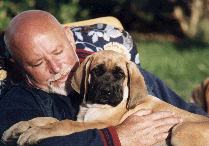
Cesare Gilardi
The most confirmed hypothesis about the origins of the Mastiff is that which would have it descended from the mythical Giant Tibetan Mastiff (now extinct) from "canis familiaris inostranzewi" already present in Asia and Northern Europe during the Bronze Age. The "canis familiaris inostranzewi" was in its turn derived from Tomarctus, the predator with short legs, which was alive between ten and five million years ago. Still, according to Studer, man looked for medium sized dogs, which had sufficient strength or size of the jaw to allow it to fight against enemies or large animals. These dogs were in general short muzzled, where the skin of the muzzle did not reduce along with the skeleton and therefore formed more or less noticeable folds. Studer maintains that in such subjects the jaws having become shorter than that of other dogs were often also more solid in order to adapt to an enormously developed set of teeth. Consequently the jaw muscles having become extremely strong that the points where they are attached are wider than in other dogs. In dogs of this type the shortened jaw becomes curved and it turns upwards in order to have a more efficient bite. In fact the jaws are similar to surgical forceps, that is to say, a third degree lever being its pivotal point in the temporal mandible articulation, the gripping (or resistance)
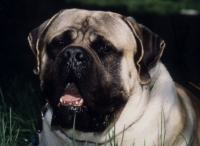 point is in the front part of the jaw between the incisors and the canines
and the power is in an intermediary zone between the gripping point and
the pivotal point. When the jaw is not only short but also curved and reassembled,
the grip not only becomes more powerful but also more efficient because
the power point, is closer to the point of resistance, that is to say, the
grip, which is not the case with long muzzled dogs. In those dogs the
masseter clonus muscle, which goes from the cheekbone arch and ends on the
mandibular arch (in the masstere pit/dimple and in the mandibular edge),
is very solid and thick. Moreover the temporal muscle is inserted on the
external skull base and fills the fossa temporalis, ending on the lower
jaw. As far as the presence of the Mastiff in England is concerned,
many are hypothetical. According to the most diffuse and evocative stories,
when Caesar's troops invaded the British Isles in 55AD they found themselves
in front of two types of dog. The first type was low, extremely stocky,
with a head out of proportion to its body, short and strong jaw that bit
at the legs of the Legionnaires causing some damage.
point is in the front part of the jaw between the incisors and the canines
and the power is in an intermediary zone between the gripping point and
the pivotal point. When the jaw is not only short but also curved and reassembled,
the grip not only becomes more powerful but also more efficient because
the power point, is closer to the point of resistance, that is to say, the
grip, which is not the case with long muzzled dogs. In those dogs the
masseter clonus muscle, which goes from the cheekbone arch and ends on the
mandibular arch (in the masstere pit/dimple and in the mandibular edge),
is very solid and thick. Moreover the temporal muscle is inserted on the
external skull base and fills the fossa temporalis, ending on the lower
jaw. As far as the presence of the Mastiff in England is concerned,
many are hypothetical. According to the most diffuse and evocative stories,
when Caesar's troops invaded the British Isles in 55AD they found themselves
in front of two types of dog. The first type was low, extremely stocky,
with a head out of proportion to its body, short and strong jaw that bit
at the legs of the Legionnaires causing some damage.These dogs, presumably ancestors of the Bulldog, would have been of Celtic origin and therefore present in England for centuries.
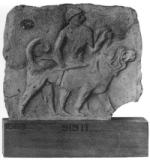 The
second type, which gave even more problems to the Roman legions, consisted
of unusually large dogs similar in every way to Assyrian Heavy Mastini and
therefore incredibly strong. We have an effective representation of these
Assyrian Heavy Mastini, ancestors of the present day Mastiff on a fragment
of earthenware found in Birs Nimrd (Ninive) and conserved in the British
Museum, London. It represents a large fighting Molloser with short hair
held by a trainer. The dog, which is of enormous stature and Herculean proportions,
is protected by a leather carapace and a lion-like mask to strike terror
into those who saw it. In support of the above theories we have the writings
of Gratius Falsicus in his work entitled "Cinegetica". According
to Gratius the English dogs, then named as "pugnaces" (ready for
battle), were absolutely superior to the Roman dogs, in general Molosser
of Ancient Greece, which the Roman infantry had taken with them when conquering
Great Britain. The Romans were fascinated by these enormous English dogs,
and after conquering the British Isles took them back with them to Rome
to use in the fighting arena against ferocious beasts. However, in the same
British Isles the Romans introduced lions and bears to oppose the powerful
The
second type, which gave even more problems to the Roman legions, consisted
of unusually large dogs similar in every way to Assyrian Heavy Mastini and
therefore incredibly strong. We have an effective representation of these
Assyrian Heavy Mastini, ancestors of the present day Mastiff on a fragment
of earthenware found in Birs Nimrd (Ninive) and conserved in the British
Museum, London. It represents a large fighting Molloser with short hair
held by a trainer. The dog, which is of enormous stature and Herculean proportions,
is protected by a leather carapace and a lion-like mask to strike terror
into those who saw it. In support of the above theories we have the writings
of Gratius Falsicus in his work entitled "Cinegetica". According
to Gratius the English dogs, then named as "pugnaces" (ready for
battle), were absolutely superior to the Roman dogs, in general Molosser
of Ancient Greece, which the Roman infantry had taken with them when conquering
Great Britain. The Romans were fascinated by these enormous English dogs,
and after conquering the British Isles took them back with them to Rome
to use in the fighting arena against ferocious beasts. However, in the same
British Isles the Romans introduced lions and bears to oppose the powerful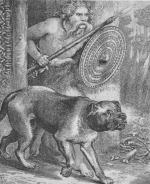 Mastiffs in the circus performances, which continued to take place in England
in one form or another up until the last century. It is in this way that
Oppiano d'apamea described the British "pugnaces" in 3AD. We
can see that they clearly have the characteristics of the Mastiff, also
demonstrated in the Roman-British ceramics (50BC) representing the hunting
of large wild animals.
Mastiffs in the circus performances, which continued to take place in England
in one form or another up until the last century. It is in this way that
Oppiano d'apamea described the British "pugnaces" in 3AD. We
can see that they clearly have the characteristics of the Mastiff, also
demonstrated in the Roman-British ceramics (50BC) representing the hunting
of large wild animals.According to the above-mentioned hypothesis Venetian merchants introduced the Mastiff into the British Isles, probably 500 to 600 years before the Roman invasions. The Venetians had commercial links both with the Assyrian and the English population. A second theory confirms that a dog which was in every way similar to the present day Mastiff had existed in the British Isles and was taken away during the period of Celtic migration to the English archipelagoes between 2000BC and 700BC. The Celts, who came from an area situated in Central Europe between Reno and Danube maintained relations with the oriental population before their migration. Therefore this second Celtic hypothesis confirms the first Asian origin of the Mastiff. After the fall of the Roman Empire the Mastiff was used as a protective guardian of the court.
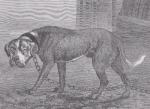 The
name "Band Dog" was given as a result of this use. Under
the Norman King Knud the Great (995 -1035) the Mastiff was cited under the
forest law, according to which every inhabited area had to be armed with
a Mastiff as protection for men and beasts against the attack of wolves
and other preying animals. Again under Henry 111 King of England and Duke
of Acquitania (1207-1272) the Mastiffs, which were kept near to the royal
forest, which were full of game, according to the law, three toes from each
hind paw removed so that it would be unable to attack the wild game. After
the Norman Conquest of Britain the language of the nobles, jurists and literature
was archaic French and the "Band Dog" was named the Mastiff. From
1300 onwards in forest law and hunting accounts the "Band Dog"
became known as "The Mastin" and then was known by the anglicized
name of "Mastiff" and also "Mestiff", "Masty",
"Masty-Hound" and "Maystiff". Even if this was the case
"Band Dog" or "Alaunt" remained in use until the Renaissance
in some English counties. At the end of the Middle Ages the 100 years war
was a determining factor not only for European history, but also for the
history of the Mastiff". Many historians tell of the fortunes of Sir
Peer Legh, who was seriously injured in The Battle of Agincourt and who
was protected and defended by his Mastiff dog and he owed his life exclusively
to her. Sir Peer's family, as recognition of this fact, reared all the descendants
of that bitch. The oldest family trees of the Mastiff have in fact named
as their earliest example the Mastiff of Agincourt. About 100 years after
the battle of Agincourt in 1515 the family Legh had the castle of Lymehall
built, which dedicated its name to a branch of Mastiff, which lasted for
the whole of the last century. Lymehall castle is presently a museum, which
brings together a wide and unique collection of works of art, sculptures,
paintings, drawings and photographs whose only subject is
The
name "Band Dog" was given as a result of this use. Under
the Norman King Knud the Great (995 -1035) the Mastiff was cited under the
forest law, according to which every inhabited area had to be armed with
a Mastiff as protection for men and beasts against the attack of wolves
and other preying animals. Again under Henry 111 King of England and Duke
of Acquitania (1207-1272) the Mastiffs, which were kept near to the royal
forest, which were full of game, according to the law, three toes from each
hind paw removed so that it would be unable to attack the wild game. After
the Norman Conquest of Britain the language of the nobles, jurists and literature
was archaic French and the "Band Dog" was named the Mastiff. From
1300 onwards in forest law and hunting accounts the "Band Dog"
became known as "The Mastin" and then was known by the anglicized
name of "Mastiff" and also "Mestiff", "Masty",
"Masty-Hound" and "Maystiff". Even if this was the case
"Band Dog" or "Alaunt" remained in use until the Renaissance
in some English counties. At the end of the Middle Ages the 100 years war
was a determining factor not only for European history, but also for the
history of the Mastiff". Many historians tell of the fortunes of Sir
Peer Legh, who was seriously injured in The Battle of Agincourt and who
was protected and defended by his Mastiff dog and he owed his life exclusively
to her. Sir Peer's family, as recognition of this fact, reared all the descendants
of that bitch. The oldest family trees of the Mastiff have in fact named
as their earliest example the Mastiff of Agincourt. About 100 years after
the battle of Agincourt in 1515 the family Legh had the castle of Lymehall
built, which dedicated its name to a branch of Mastiff, which lasted for
the whole of the last century. Lymehall castle is presently a museum, which
brings together a wide and unique collection of works of art, sculptures,
paintings, drawings and photographs whose only subject is 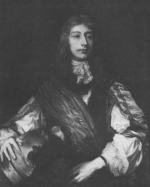 The
Mastiff. This collection was brought together by Mrs. Maria Antonietta Moore,
a wealthy breeder and judge of the American Mastiff, also author of a wonderful
book about the breed. Following the breeding kennels at Lymehall other important
stock emerged such as that of Chatsworth, belonging to the Duke of Devonshire
and Lord Harrington's Elvaston Castle. In brief, the Mastiff became the
favourite pet of the noble landowners, which carefully bred them in their
own castles. The Old English Mastiff has been
written about by poets and writers. In William Shakespeare's drama
"Henry V" two French officers talk about the dogs' courage, valour,
and aggression after the Battle of Agincourt, which made them highly esteemed
dogs of war. Also as guard dogs they were noted for their loyalty and incorruptibility.
The Mastiffs were also used for the hunting of bears and wild boars: their
extremely strong jaws, once clenched, were deadly. Taking all this into
consideration, the primary use of the Mastiff was always to guard and protect
property and the court. This is well expressed by Giovanni Caius Doctor
of Physics at Cambridge University and also personal doctor to Queen Elizabeth
1, in his treatise " De Canibus Brittanicus". Amongst the many
uses for which the Mastiff is famous from Roman times up to the end of the
last century there are also some less noble activities such as, fighting
spectacles against bears, bulls and lions.
The
Mastiff. This collection was brought together by Mrs. Maria Antonietta Moore,
a wealthy breeder and judge of the American Mastiff, also author of a wonderful
book about the breed. Following the breeding kennels at Lymehall other important
stock emerged such as that of Chatsworth, belonging to the Duke of Devonshire
and Lord Harrington's Elvaston Castle. In brief, the Mastiff became the
favourite pet of the noble landowners, which carefully bred them in their
own castles. The Old English Mastiff has been
written about by poets and writers. In William Shakespeare's drama
"Henry V" two French officers talk about the dogs' courage, valour,
and aggression after the Battle of Agincourt, which made them highly esteemed
dogs of war. Also as guard dogs they were noted for their loyalty and incorruptibility.
The Mastiffs were also used for the hunting of bears and wild boars: their
extremely strong jaws, once clenched, were deadly. Taking all this into
consideration, the primary use of the Mastiff was always to guard and protect
property and the court. This is well expressed by Giovanni Caius Doctor
of Physics at Cambridge University and also personal doctor to Queen Elizabeth
1, in his treatise " De Canibus Brittanicus". Amongst the many
uses for which the Mastiff is famous from Roman times up to the end of the
last century there are also some less noble activities such as, fighting
spectacles against bears, bulls and lions.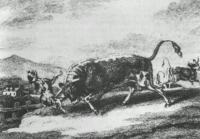
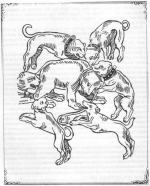
In the Renaissance the ratio was three Mastiffs against one bear and four against a lion. Queen Elizabeth 1, who, as with the case of her father, certainly did not have any moral scruples, had a predilection for such "entertainment". When she travelled around the English realm, tournaments between Mastiffs and bears were organized in her honour. In fact the Mastiffs were favoured by Elizabeth 1 who also kept several in a wing of the castle where she lived.Lord Buckhurst, the Queen's ambassador in France owned an enormous Mastiff, which was said to have massacred a bear, a lion, and a leopard in the arena. It is true that ther
 e
is certainly some degree of exaggeration in all of this, but this fact shows
the way in which the giant English mastiff was considered.Even Queen Elizabeth
1's sovereign successors shared this passion with her for the Mastiff and
the cruel spectacles where it was a protagonist. As a result the Mastiff
was extolle
e
is certainly some degree of exaggeration in all of this, but this fact shows
the way in which the giant English mastiff was considered.Even Queen Elizabeth
1's sovereign successors shared this passion with her for the Mastiff and
the cruel spectacles where it was a protagonist. As a result the Mastiff
was extolle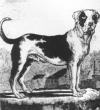 d
in English and Scottish fables, ballads and poetry as being the national
guard dog. It must be pointed out thatat that time the dogs were selected
according to the roles they were to play, rather than in conformity with
morphological criteria as happens now,
d
in English and Scottish fables, ballads and poetry as being the national
guard dog. It must be pointed out thatat that time the dogs were selected
according to the roles they were to play, rather than in conformity with
morphological criteria as happens now,  demonstrated
by the copious amount of material, which can be found dating back to the
Middle Ages. In the 19th Century the breed began to be bred in its pure
form, and in fact the decade 1870-1880 was one of the most favourable for
the development of the breed. In 1872 during a dog show at Crystal Palace
in London as many as 81 Mastiffs were shown. In 1833, still at Crystal Palace
the breed's own club was founded with
demonstrated
by the copious amount of material, which can be found dating back to the
Middle Ages. In the 19th Century the breed began to be bred in its pure
form, and in fact the decade 1870-1880 was one of the most favourable for
the development of the breed. In 1872 during a dog show at Crystal Palace
in London as many as 81 Mastiffs were shown. In 1833, still at Crystal Palace
the breed's own club was founded with 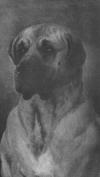 the
name Old English Mastiff Club. The first dogs to be shown were Turk,
a well-formed dog but with a long muzzle, Beaufort, Wolsey, and above
all the great Peter Piper, which was reproduced in a lithograph,
which show
the
name Old English Mastiff Club. The first dogs to be shown were Turk,
a well-formed dog but with a long muzzle, Beaufort, Wolsey, and above
all the great Peter Piper, which was reproduced in a lithograph,
which show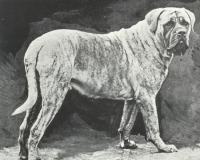 s
an extraordinary example of the dog. No matter how much has been written
about him, that he had a protruding upper jaw, with a very short muzzle,
on the whole the head we see in the lithograph is very effective because
of the expression and the characteristic wrinkling on the forehead, which
is still essential today.
s
an extraordinary example of the dog. No matter how much has been written
about him, that he had a protruding upper jaw, with a very short muzzle,
on the whole the head we see in the lithograph is very effective because
of the expression and the characteristic wrinkling on the forehead, which
is still essential today. At the beginning of the 1900s the breed continued to make itself known with different events and with a quite considerable number of registrations to the Kennel Club. Some breeders supported the necessity for a short head with strong brachynathie; others supported a short head, which was in better harmony with the body. The muzzle, which was 33%-34% of the total length of the head, was considered to be the best. The expression had to be noble and solemn. The First World War badly hit the development of the breed. Compared with the Kennel Club registration of 60 puppies in 1913 and 54 in 1914, in 1918 there were only 3. The Mastiff population had been decimated due to the war. This is what made necessary up until 1930 the repeated cross breeding with the BullMastiff. This breed, which was recognized in 1924 but was really 100's of years old, was still in a phase of recognition after the First World War even if its representatives, smaller than the heavy large Mastiffs had better withstood the effects of the conflicts. This cross with the Bullmastiffs was necessary to save the breed from extinction. Some important English breeders contested this, above all Mr. Oliver who was proud of his pure bred stock. The result of the Hellingly affix was 3 males, which produced the history of the breed at the beginning of the 30's. These were Marcesman of Hellingly, Cardinal of Hellingly and above all Joseph of Hellingly who became patriarch of this important Kennel. Also in this period (exclusively in the Hellingly Kennels) the Bullmastiff was introduced whose influence was then partially eliminated. Nevertheless the very short muzzles still found in some English kennels, clearly show that the presence of the Bullmastiff in the old English Mastiff is still felt. In place of the name of an ancestor in pedigrees from the 1920's a comment such as "not registered", "unknown" or "Bullmastiff" can be found.
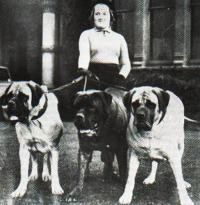 .In this period kennels such as Miss Bell's Withybush and Mrs. Scheerboom's
Havengore, along with the above mentioned Hellingly became the pillars on
which the breed was to be built. Famous dogs other than the already mentioned
example from Hellingly were the beautiful Ch. Young Mary bull which nevertheless
revealed the influence of the Bullmastiff and the Ch. Miss Bull coming from
the same period we also have Broomcourt Jem bred by Mr. Bennett and owned
by Miss Janet Bell, the famous Broomcourt Romeo, which also however
shares certain bullmastiff features with its light convergence. An excellent
example from the 1920's was the Champion Stella Menai. In the 30's and 40's
the Mastiff had a period of great splendour with the production of excellent
typical powerful dogs. For these qualities we must mention the dogs of Havengore
Addam and Sammy, but above all the striped Drake of Havengore was considered
to be the most handsome non- mastiff ever seen.
.In this period kennels such as Miss Bell's Withybush and Mrs. Scheerboom's
Havengore, along with the above mentioned Hellingly became the pillars on
which the breed was to be built. Famous dogs other than the already mentioned
example from Hellingly were the beautiful Ch. Young Mary bull which nevertheless
revealed the influence of the Bullmastiff and the Ch. Miss Bull coming from
the same period we also have Broomcourt Jem bred by Mr. Bennett and owned
by Miss Janet Bell, the famous Broomcourt Romeo, which also however
shares certain bullmastiff features with its light convergence. An excellent
example from the 1920's was the Champion Stella Menai. In the 30's and 40's
the Mastiff had a period of great splendour with the production of excellent
typical powerful dogs. For these qualities we must mention the dogs of Havengore
Addam and Sammy, but above all the striped Drake of Havengore was considered
to be the most handsome non- mastiff ever seen. 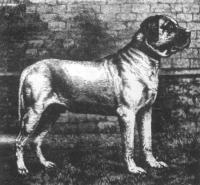 During
the 2nd World War the breed's situation fell. In the first part of the conflict
some examples of the breed were sent to the USA and Canada to save them
from the bombardment and famine. Vice versa the dogs, which remained
in England, could not be fed due to lack of food. During the war only 2
litters were registered. At the end of the war, only one bitch from these
litters was able to breed. Her name was Sally of Coldblow. She was coupled
with males brought back from the USA and altogether she produced 30 puppies.
Which in substance was the whole Mastiff population in England. Due to this,
excessive in-breeding could not be helped, brother and sister, father and
daughter, mother and son - these couplings guaranteed the survival of the
breed but a high price was paid, reducing the vital anomalies the fertility
and increasing the hereditary defects, particularly of character. Mrs. Nora
Dicken was very active in this period and she personally went to the USA
and Canada to acquire in the name of the Club, some subjects she managed
to locate after a long pursuit. Even after the 2nd World War some cross
breeding with Bullmastiffs took place. These crossbreeds however did not
have a determining influence in the following years and the breeds again
managed to produce examples with excellent typology. Amongst these was Jason
of Copenore, an excellent stud that was not particularly tall but stocky
with excellent expression. A real champion was Copenore Rab, owned by Mrs
Degerdon, who produced the beautiful bitch Grangemoor Nell. Another famous
dog was Milf Murias, still from Mrs. Degerdon, who gave the start to another
series of winners both in England and America. Other important post war
kennels were Dr Allison's Weatherhill, Mrs Craigh's Kisumi and the still
active Bulliff Kennel, located on the outskirts of Oxford, belonging to
Mr. and Mrs. Say. Unfortunately in 1960 the death of Miss Janet Bell who
had been active in breeding since 1925 was a hard blow to the breed, also
because she stated in her will that all her Mastiffs over the age of 18
months be eliminated. To carry out her wishes 17 dogs were destroyed. Only
one bitch that was suckling puppies and 3 puppies remained, amongst these
the excellent Withybush Superbus who originated an excellent bloodline.
After the 1960's new kennels were created which further increased the breed.
Mrs. Degerdon, owner of affix Grangemoor, transferred to America, produced
a series of notable champions, amongst which Grangemoor Bevis and Grangemoor
Cadivor. One of Mrs. Degerdon's dogs that was a champion gave Devil of Hollesley,
the above mentioned Max of Parnal America's origin. At this moment in time
the Mastiff is widely diffuse in America where it is bred according to a
standard 'American Bred Standard', different in some respects to the English
standard. In Europe, as well as in its homeland, where along with the Bulldog,
they are two symbol breeds; it is slowly but surely spreading with more
than satisfactory results.
During
the 2nd World War the breed's situation fell. In the first part of the conflict
some examples of the breed were sent to the USA and Canada to save them
from the bombardment and famine. Vice versa the dogs, which remained
in England, could not be fed due to lack of food. During the war only 2
litters were registered. At the end of the war, only one bitch from these
litters was able to breed. Her name was Sally of Coldblow. She was coupled
with males brought back from the USA and altogether she produced 30 puppies.
Which in substance was the whole Mastiff population in England. Due to this,
excessive in-breeding could not be helped, brother and sister, father and
daughter, mother and son - these couplings guaranteed the survival of the
breed but a high price was paid, reducing the vital anomalies the fertility
and increasing the hereditary defects, particularly of character. Mrs. Nora
Dicken was very active in this period and she personally went to the USA
and Canada to acquire in the name of the Club, some subjects she managed
to locate after a long pursuit. Even after the 2nd World War some cross
breeding with Bullmastiffs took place. These crossbreeds however did not
have a determining influence in the following years and the breeds again
managed to produce examples with excellent typology. Amongst these was Jason
of Copenore, an excellent stud that was not particularly tall but stocky
with excellent expression. A real champion was Copenore Rab, owned by Mrs
Degerdon, who produced the beautiful bitch Grangemoor Nell. Another famous
dog was Milf Murias, still from Mrs. Degerdon, who gave the start to another
series of winners both in England and America. Other important post war
kennels were Dr Allison's Weatherhill, Mrs Craigh's Kisumi and the still
active Bulliff Kennel, located on the outskirts of Oxford, belonging to
Mr. and Mrs. Say. Unfortunately in 1960 the death of Miss Janet Bell who
had been active in breeding since 1925 was a hard blow to the breed, also
because she stated in her will that all her Mastiffs over the age of 18
months be eliminated. To carry out her wishes 17 dogs were destroyed. Only
one bitch that was suckling puppies and 3 puppies remained, amongst these
the excellent Withybush Superbus who originated an excellent bloodline.
After the 1960's new kennels were created which further increased the breed.
Mrs. Degerdon, owner of affix Grangemoor, transferred to America, produced
a series of notable champions, amongst which Grangemoor Bevis and Grangemoor
Cadivor. One of Mrs. Degerdon's dogs that was a champion gave Devil of Hollesley,
the above mentioned Max of Parnal America's origin. At this moment in time
the Mastiff is widely diffuse in America where it is bred according to a
standard 'American Bred Standard', different in some respects to the English
standard. In Europe, as well as in its homeland, where along with the Bulldog,
they are two symbol breeds; it is slowly but surely spreading with more
than satisfactory results.